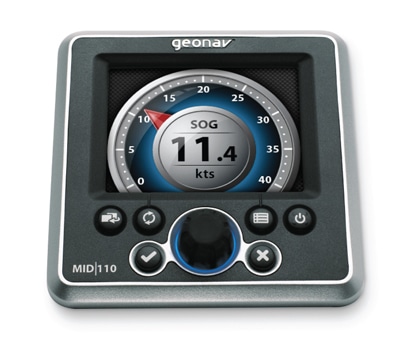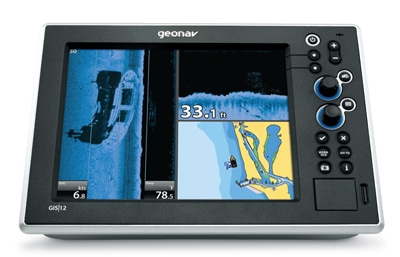When we first heard about Geonav’s broad-shouldered plans to apply Yankee ingenuity while building powerful navigation equipment, we wanted an early peek at it. What we experienced was elegant, durable hardware, 100 percent ready for the market but, at that time, running software that was still under development. Rushing our test, we operated it on beta test software that, by the time you read this, according to Geonav sources, will be ready to give boaters an entirely new bouquet in marine navigation. Just as an experienced vintner can predict the quality of wine from a whiff of raw grape juice, we could predict a great vintage for Geonav electronics.
Geonav was a division of Navionics, based in Italy and acquired by the same company that owns Humminbird, the ultrasuccessful navigation brand in American freshwater fishing. After Geonav was relocated to a Eufaula, Alabama, factory, the company looted top electronics employees from the best brands to refine this NMEA 2000-compatible system into a function-rich suite of navigation features that includes sonar, Side Imaging sonar, dual-band radar, automatic identification system (AIS) and auto pilot. Geonav also offers a multifunction display that can be linked to any engine function, such as revolutions per minute, fuel flow, engine temperature, sonar, water temp or, well, just about anything.

BlueLogic proprietary software makes functions beautifully addressable by using a combination of precise button and dial controls: we could quickly choose the settings we wanted in moving seas. For easy operation, the X-Press menu button brings down only the menu for the active screen, be it radar, sonar or chart plotter. It takes time for a boater to fully grasp any operating system, but this one is uniquely simple.
HaloView is Geonav’s customizable pane setup window. This is the first rotating or “carousel-type” pane manager we’ve seen that let us put our favorite functions, like GPS, sonar and side-scan sonar, on the front “horses.” Easy-to-use controls made it simple to grab the function panes we wanted and put them where we wanted them on the rotating carousel.
DualFuel, the Geonav software that simultaneously displays two mapping systems in separate panes on the same or linked units, added to the wow factor. By posting Navionics Platinum + cartography side by side with Jeppesen C-Map 4D systems’ raster maps, for instance, we had full National Oceanic and Atmospheric Administration info plus the benefit of C-Map’s extensive and hugely accurate navigation library. The resulting images on the crisp screen provide information so concise it adds confidence to navigators experiencing new waters for the first time.
For more confidence, just as is capable on Garmin and Furuno systems, users can adjust contour colors for danger depths for specific vessels.

The Side Imaging sonar set up on our test system was running on automatic settings, and as we ran in 10 feet of water at 30 mph, we could clearly see the sand drifts created by currents. Objects to the side appeared as bright spots, and we could judge their distance from the bottom by the objects’ distance from their shadows. Spotting individual fish or bottom structure was easy, and so was saving the spot as a waypoint.
Ethernet radar (4 kw) is available with radome or 4- or 5-foot open arrays and can be networked to cockpit and bridge helm stations — or as many stations as you choose. Use a Geonav flux-gate compass to accurately layer radar images over the charts.
Autopilot is also available, and our test equipment held us on a multipoint course we set back to the inlet, making safe, steady turns around 90-degree course changes.
NMEA 2000 compatibility means these chart plotters and multifunction displays can also display all engine functions on NMEA-compliant engines, or trim tab position and fuel or other fluid levels.
MFDs can be used to replace analog engine instruments and are completely programmable to toggle between the functions you want to show, be it rpm, miles per hour, fuel flow, engine temp — you dream it up, and these displays can show it on their crisp, color LCD screens with soft-blue LED backlighting.
OK, I’ll admit our beta test software was preproduction and not quite up to snuff, but that was being addressed already. what we saw, though, told us that when you pop the cork on the latest stuff this spring, you’ll know 2011 is a great year for Geonav — and for boaters who choose to install it.








